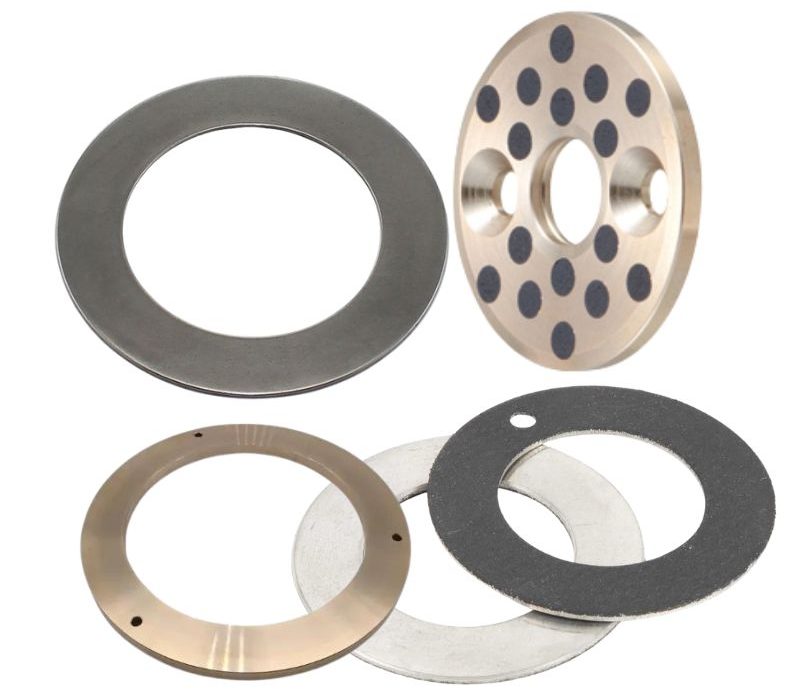Table of Contents
Categories
-
Adapter Sleeves (9)
-
Ball Bearings (11)
-
Ball Screw Bearings (2)
-
Ceramic Bearings (27)
-
Pillow Block Bearings (4)
-
Plain Bearings (32)
-
Roller Bearings (12)
-
Slewing Bearings (43)
-
Sliding Block (3)
-
Stainless Steel Bearings (27)
-
Super Precision Bearings (6)
-
Thin Section Bearings (9)
-
Track Rollers (4)
-
Universal Joints (1)
Thrust Washers: What They Are and How They Work

Thrust washers are an important component of many machines, including engines, transmissions, and pumps. They are used to reduce friction and wear between moving parts, and to prevent them from binding together.They help to keep the parts running smoothly and prevent damage from occurring.
Thrust washers are typically made of a hard material, such as steel or bronze, and are shaped like a washer or a thin disk. They are installed between two mating surfaces, such as the crankshaft and the bearing housing in an engine.As the two surfaces move against each other, the thrust washer creates a barrier that prevents them from coming into direct contact. This reduces friction and wear, and helps to keep the parts lubricated.
Thrust washers can also help to prevent the parts from binding together. If the two surfaces were to come into direct contact, they could become stuck and unable to move. The thrust washer creates a slight gap between the surfaces, which prevents this from happening.
Types Of Thrust Washers
There are two main types of thrust washers: static and dynamic.
- Static thrust washers are permanently installed between two mating surfaces. They do not move with the parts, and they are typically made of a hard material, such as steel or bronze.
- Dynamic thrust washers are able to move with the parts. They are typically made of a softer material, such as a polymer or a composite, and they are designed to wear out over time.
Dynamic thrust washers are often used in applications where there is a lot of movement between the parts. They help to reduce friction and wear, and they also help to keep the parts lubricated.



How To Select A Thrust Washers
When selecting a thrust washer, it is important to consider the following factors:
- The size of the washer
- The material of the washer
- The type of application
The size of the washer must be matched to the size of the mating surfaces. The material of the washer must be able to withstand the conditions of the application. For example, a washer used in an engine must be able to withstand high temperatures and pressures.
The type of application will also determine the type of thrust washer that is needed. For example, a static thrust washer would be used in an application where the parts do not move, while a dynamic thrust washer would be used in an application where the parts move a lot.
Thrust Washers Installation
The installation process of thrust washers includes the following steps:
- Preparation of tools: before installing thrust washers, it is necessary to prepare the appropriate tools, such as clamps, spanners, etc.
- Determine the installation position: Before installing the thrust washer, it is necessary to determine its installation position. Thrust washers are usually installed on the crankshaft to prevent the crankshaft from swinging from side to side.
- Determine the direction of installation: The direction of installation of the thrust washer is very important. When installing the thrust washer, it is necessary to ensure that the oil groove of the thrust washer is facing towards the crankshaft to facilitate lubrication.
- Install the thrust washer: After determining the installation position and direction, you can start to install the thrust washer. Using a tool such as a clamp or spanner, slowly push the thrust washer into the crankshaft until the thrust washer rests completely against the side of the housing.
- Checking the quality of the installation: After the installation is complete, it is necessary to check the quality of the thrust washer installation. Make sure that the thrust washer is correctly positioned and is not bent or damaged.
What Are The Applications Of Thrust Washers?
The application scenarios of thrust washers mainly include the following aspects:
- Automotive crankshaft: thrust washers are usually installed on automotive crankshafts, used to prevent the crankshaft and thrust washers from friction heat and lubrication to protect the crankshaft and related parts from damage.
- Cage guiding method: thrust washers can be used to keep the cage guiding method, to ensure that the frame in the operation process to maintain the correct position and direction, to prevent common vibration and high-speed running friction resistance
- Deep groove ball bearings: thrust washers can be applied to deep groove ball bearings to protect the bearings from damage by excessive pressure and prolong their service life.
- Mechanical equipment: thrust washers can be applied to a variety of mechanical equipment, such as anti-loosening washers, lock washers, double-stacked self-locking washers, etc., in order to improve the performance and stability of the equipment
- Adjustment of the base position: thrust washers can be used to adjust the position of the base on the pedestal, so that the base and schematic arrangement in line with the performance of the equipment to improve


In short, thrust washers are an important part of many machines. They prevent excessive wear by reducing friction between moving parts. By understanding how thrust washers work, you can use them to improve the performance and longevity of your machine and protect the parts involved from damage.
References
1.Additional information on ”thrust washers“ from STEEL THRUST WASHER MANUFACTURING
2. Something about “thrust washers” from SAINT-GOBAIN ;
3. About “Thrust Washer” Types MISUMI .


















